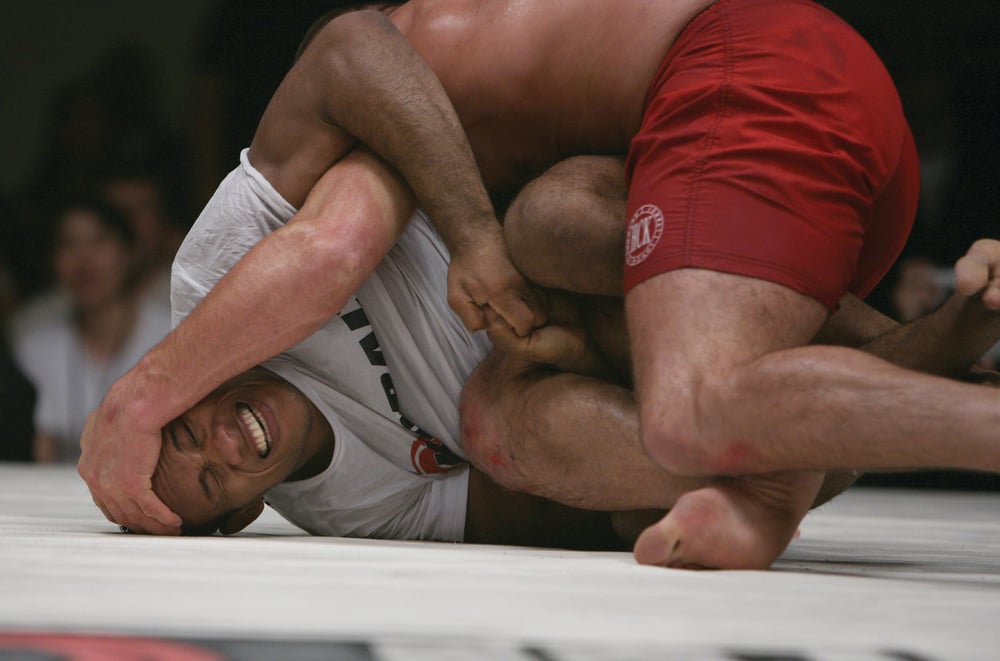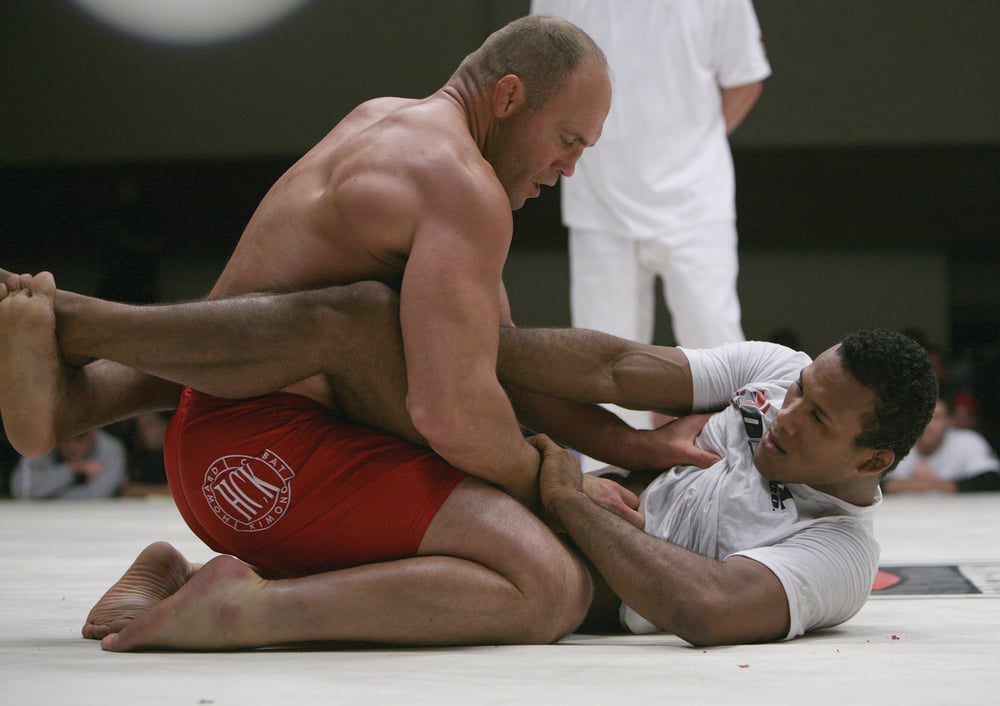
Issue 023
March 2007
I remember the first time I walked in on a grappling session in a mixed martial arts (MMA) gym. A mass of bodies, sweating and steaming, quite literally rolled around on the floor while they smashed their fists into focus mitts held by a partner. The blare of the stereo competed with the tattoo of blows crashing into leather, the coach’s voice barking instructions over the grunts of exertion from his charges.
I was immediately struck by the energy and sheer reality of what I saw. Back the same time the following week only wearing my gym clothes and ready for my first taste of MMA, I stepped onto the mat and was given my biggest ego-check to date. I was pinned, stretched, choked and submitted relentlessly for an entire hour. It felt like a lot longer. To add to the indignation, I was armbarred by a girl who weighs no more than 125lbs (56kgs), but that was it for me. I didn’t know why, but this grappling thing struck a chord in me, and I knew from this time on that was something I had to pursue. Little did I know it would take over my life.
While mixed martial arts, no holds barred, Vale Tudo, submission fighting, or whatever you want to call it is my bread and butter, I spend more time engaging in straight grappling training. Why? Well, its easier on my body, and I’ve got no plans to fight again any time soon. Give me an easy option and I’ll take it, and for me, grappling is just that.
Accessible, cheap, and with somewhat less of stigma than ‘cage fighting’, grappling is one of those things that provokes very little reaction from people when you mention it to them. Tell them you fight in a cage and their eyes will widen, but let them in on that fact you get throttled and throw people around a couple of times a week and they just think you’re a bit odd. Maybe this is because MMA is quite a new thing, and it stirs up strong emotions among those who encounter it, and in contrast grappling dates back to the ages and is present in many different forms.
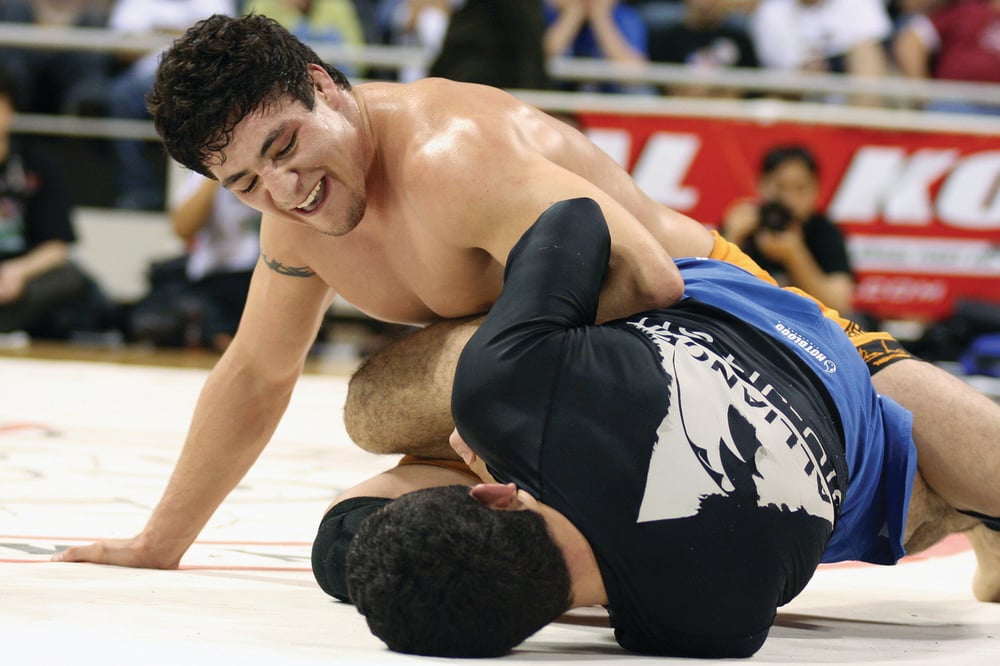
The different faces of grappling
Submission wrestling as it is now is a hybrid style of grappling that has its deepest roots in the recent phenomenon of Brazilian Jiu-Jitsu (BJJ). Grappling as a whole is an ageless sport with many different faces, and to put things in perspective BJJ is less than a hundred years old. The art of Brazilian Jiu-Jitsu came to public attention when Rorion Gracie devised the Ultimate Fighting Championship as a way of showcasing his family art in 1993. Putting his brother Royce in with a succession of unsuspecting and poorly trained martial artists on the premise this was as close to a real fight as you could get was a masterstroke. When Royce submitted opponent after opponent, the world of combat sorts sat up and took note, and after years of being derided and ignored, grappling was suddenly the ‘in’ thing to do.
Everyone who wanted to fight wanted to learn submissions, but not only that, people straight out wanted to learn how to grapple. Billing their art as a complete self defence system the Gracie family drew hundreds of students in schools and academies around the USA and further still, beginning a trend that endures to today. Instead of going to a karate school, people went to a grappling gym.
As the popularity of BJJ grew, so did that of other grappling sports. ‘No-gi’ submission wrestling, so described because of the lack of the trademark jiu-jitsu kimono, became increasingly popular among practitioners in the USA, much as it had among those in Brazil years before. No-gi submission grappling appealed to many westerners put off by the Oriental-influenced kimono, and also attracted those from other grappling disciplines, such as free style wrestling.
For mixed martial arts, submission grappling and jiu jitsu was found to work best in competition. Though they are hybrid fighters with a wide range of skills, many top ranked MMA fighters come from grappling backgrounds; Randy Couture, Dan Henderson and Matt Lindland, all wrestlers; the Noguiera brothers and the rest of the Brazilian Top Team, some of the best jiu jitsu stylists in the world; the ‘young American’ black belts who ply their trade in MMA and submission grappling, men like BJ Penn, Dean Lister, Chris Brennan and more.
The one thing that you, me and almost everybody who is a grappler has in common with the above names is this: grappling took over our lives.
Grapplers behaving badly
It isn’t just fighters who find themselves bitten by the bug though. As in my case, recreational athletes get sucked in by the artistry of the techniques, the fraternal bond with your training partners and the sheer kickass-ness of being able to choke a sucker out.
As expected, macho guys get attracted to mat culture. Just as is the case with boxing gyms around the world, tough guys and wannabe’s stroll in thinking their street-tough attitude and bloated biceps will see them through a session. These so-called Alpha males often last barely a couple of minutes before being tossed around, choked out or having their limbs twisted. Sometimes their pride takes a dent and they don’t come back, but more often the zero-bullshit atmosphere they encounter inspires them to change their ways.
Some guys get a handle on their egos, but some don’t. Guys who are dicks are usually that way for a good reason, and chances of them ever changing are slim. Sometimes these guys get quite good at grappling, and whether they’re allowed to foster their attitude by the place in which they train or whether they go off and open up their own place, either way a guy with an attitude plus skills equals a dick who should be approached carefully.
Sadly, testosterone and being able to fight usually mean a willingness to throw down, and there are plenty of stories of grapplers squaring off in public brawls. The 70’s and 80’s in Rio De Janeiro are particularly noted as being rough times, with pitched battles between jiu jitsu practitioners and their no-gi Luta Livre rivals happening up and down the beaches of Brazil.
In Brazil the issue was as much about class as it was about young men looking to prove themselves (those who train in jiu jitsu were often wealthy and from middle to upper class backgrounds. Luta Livre guys were snidely referred to as too poor to buy a gi) but notable clashes that are freely available on public record include Rickson Gracie battling bitter enemy Huge Duarte on a Rio beach.
If the leaders of the sport were at it, what about the rank and file? They weren’t much better, and newspaper reports from Brazil have labelled them Pit Boys. Upper class youths with plenty of money, they learn BJJ and have become notorious for their acts of violence, especially against gay men. It seems machismo and some training in combat arts don’t always mix too well.
Surf’s up!
On a lighter note, not all grappling-related sub cultures are bad, and you need only look to the beaches of California and Hawaii for examples of this, two American states where many people choose a life that revolves around surfing and partying. But now you’re just as likely to find a surfer with a gi in the back of his car as a wetsuit. One look at the no-gi scene will give you no end of comparisons with surf culture, and this was partly due to many Brazilian grapplers being big fans of surfing. The hand gestures, the grappling boardshorts and more, all are surf-based in origin.
Native Hawaiian surfers, renowned as fiercely territorial and proud of their tradition as former warriors, are one group of extreme sports enthusiasts who flock to grappling. With grappling academies on almost every island, Hawaii boasts many top jiu-jitsu and MMA fighters, names such as BJ Penn, Falaniko Vitale, Ronald Jhun, Egan Inoue, ‘Bozo’ Palling and more, with many of them avid surfers.
Even without the direct links to extreme sports, you would only have to look at mixed martial arts, BJJ and submission grappling today to see a sub culture all of its own in definite action. With its own lingo, fashion, celebrities and so on, grappling really does become a lifestyle for many people. As in the case of not only myself but many people I know, no holiday or trip abroad is booked without first checking out potential training in advance. Presented with a holiday destination, the first question that springs to my mind is “I wonder if there is somewhere I could I get a roll there?” Whereas some people go on skiing or water sports holidays, it is increasingly popular for grapplers to go on training trips with world-class teachers as a way of relaxing!
The business of grappling
As the numbers of those living the mat culture life grow, so do the opportunities for businesses to develop and thrive as a result. With people talking the talk, wearing the clothes and generally living the lifestyle, it is only right that the leading athletes benefit as a result. You need only look at events such as the Professional Sub League (PSL), a recently created competition that features many names from the world of MMA among
its athletes.
The Abu Dhabi (ADCC) is seen as the world cup of grappling, with a huge event every two years that draws the best no-gi guys in the world to one place. Even amateur events such as the PanAms draw in almost 1000 competitors, and they continue to grow.
The latest innovation in grappling competition is the 10K Ground Clash, a 32-man submission tournament that will see the winner walk off with a cool £10,000. As Jude Samuel, director and founder of the European Fight Network Ltd and the Urban Gorillaz Grappling Challenge (not to mention a BJJ black belt and instructor under Roger Gracie) says, “It’s the biggest purse for grappling outside of ADCC and even higher than most MMA shows. The real special thing about this event is that it’s in the UK. We have never had anything like this before and it’s a chance for our home breed of fighters to showcase what they know against the higher ranked grapplers in the world. We sometimes get caught up in the hero worship of the American scene and forget what we have over here in the UK. We have a good crop of fighters from the MMA scene right through to the BJJ and submission grappling scene. I think this event will generate interest back into grappling and raise our level to where it should be. Then all will benefit, submission grappling and [most of all] MMA.”
With big names from the world of grappling and MMA poised to compete, expect something big from the 10K Ground Clash. “It is going to be grappling’s version of K-1. We have made the rules in order to favour the person who is looking for the submission, so we are expecting some serious action. Stalling is defiantly frowned upon.”
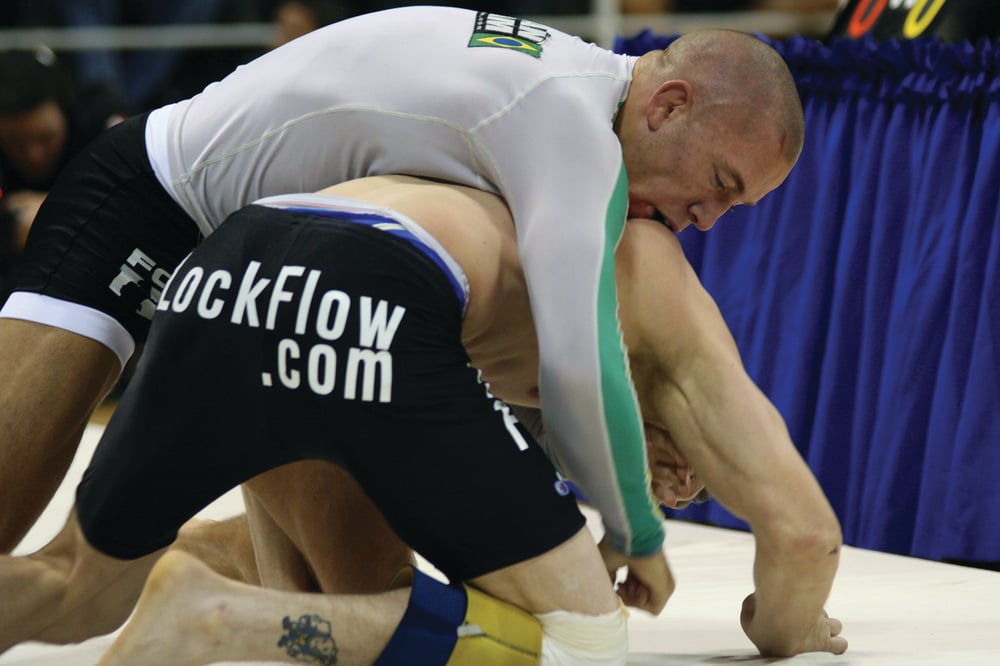
Where lies the future?
As business grows and things move along, you might wonder if grappling could end up like many of the ‘extreme sports’ and become watered down by becoming trendy. One individual who is perfectly placed to comment on the position of grappling’s popularity and it’s potential future is Caleb Queern, host of the FightWorks Podcast radio show (thefightworkspodcast.com). “I’m not sure how it’s preventable, or honestly, if it’s even a bad thing. Personally I’d like to see it on the same level as the most widely known sports out there, [BJJ and MMA] have risen in popularity together, and definitely fuel each other’s mainstream acceptance. I think it’s safe to say that once you’re into BJJ and submission grappling, it’s very likely you’re a fan of MMA.
“Based on feedback received at The FightWorks Podcast, I know it’s getting very big in English speaking countries. I can say that in addition to the popularity we’ve seen in North America, that the UK and Scandinavian countries have really adopted the sport, and there’s evidence that Australia and New Zealand are doing so as well.”
Brazilian Jiu Jitsu and submission grappling are first cousins to MMA, and tend to go hand in hand more readily than say kickboxing or Muay Thai. It may be that there is a greater crossover of athletes from grappling into MMA, or it may be that grapplers appreciate MMA more than pure striking fans.
Mat culture isn’t just a growing phenomenon – it is a legitimate and huge happening, and its taking over the planet. With the growth of MMA, BJJ and submission grappling are sure to continue to thrive.
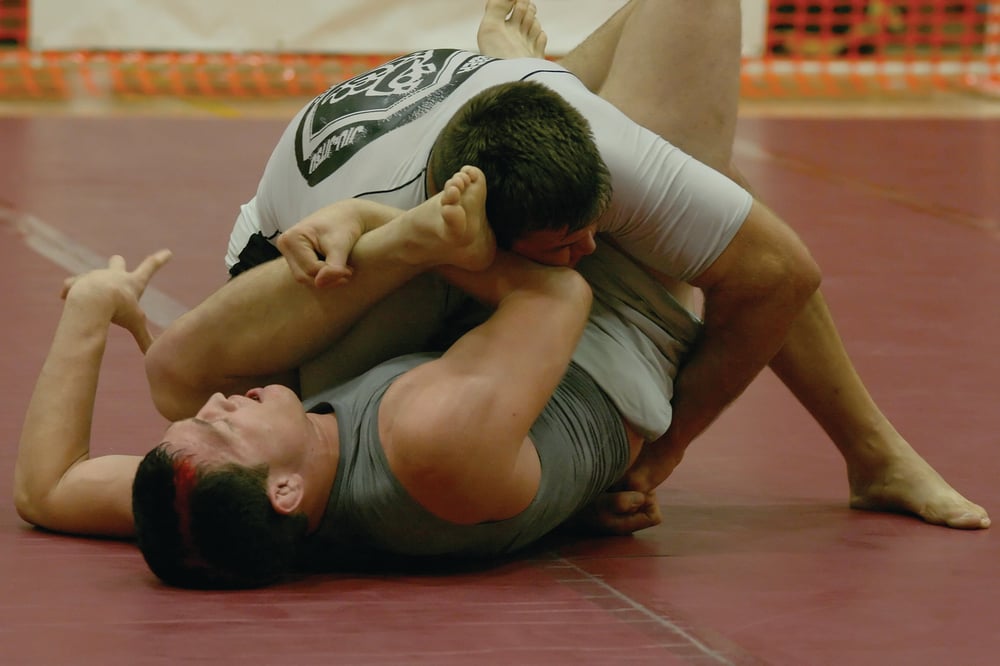
Getting to grips with grappling
So you’ve read about it, and now you want to give it a go! Getting to grips with grappling is pretty straightforward so long as you know what you’re looking for when you check out a prospective club.
“New students should look at the conduct of the students at the academy and the relationship between them and their instructors,’ advises Jude. “Is enough attention paid to everyone? Do they have a program set out for you? As a team how do they do in tournaments? Once you get your answer you will then understand that there is team spirit at that academy, everyone enjoys their jiu jitsu and what they are teaching must be good.”
As Caleb Queern explains, there are plenty of positives to training in grappling. “The great thing about grappling and BJJ is that you can have a great time doing it, become completely immersed in it, and you should be able to return to the office on Monday without any black eyes, a la Fight Club.
“It’s great for those who want to learn self-defense and fighting skills they see in MMA matches, with less of an impact on their body. The biggest risk can be that your girlfriend will be angry at the time you spend on the mats and away from her! It’s very addictive.”
The 10K Ground Clash will be held in London on the 11th March. With names such as Jeff Monson, Jess Liaudin, Chris Bright, Haim Gozali, Mario ‘Sukata’ Neto, Xande Riberio, Braulio Estima, Gabriel Kitobar, Lucio ‘Lagarto’ Rodigues, Rafael Lovarto Junior and many more expected to appear, it promises to be the biggest grappling event in UK history.
...

